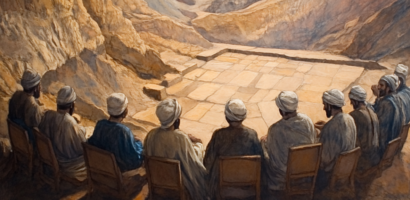The Torah very often uses a beautiful literary structure. The basic idea is that words, phrases, or other elements can be arranged to mirror each other, so that the text lays out a given set of meanings and then goes back through their parallels in the reverse order. Analyzing the use of chiasm (the formal name of this literary structure) can reveal a text’s intricate design and holistic nature. While most we usually remember is how the human and animal world was saved through the ark built by Noah, is it possible that we have almost completely missed the very point of this ancient Hebrew story?
Commonly pairs such as A and A’, B and B’ and so on are used to symbolize these “mirrored” elements. If we analyze the story of Noah in this way, we see a long pattern climaxing in line P (which lacks a parallel and signifies the main point) at the center of the chiasm. Here is an outline to illustrate the thematic chiasm in Genesis 6-9:
A Noah (6:10a)
__B Shem, Ham, and Japheth (6:10b)
___C Ark to be built (6:14-16)
____D Flood announced (6:17)
_____E Covenant with Noah (6:18-20)
______F Food in the ark (6:21)
_______G Command to enter the ark (7:1-3)
________H 7 days waiting for flood (7:4-5)
_________I 7 days waiting for flood (7:7-10)
__________J Entry to ark (7:11-15)
___________K The LORD (YHWH) shuts Noah in (7:16)
____________L 40 days of flood (7:17a)
_____________M Waters increase (7:17b-18)
______________N Mountains covered (7:19-20)
_______________O 150 days: water prevail (7:21-24)
________________P GOD REMEMBERS NOAH (8:1)
_______________O’ 150 days: waters abate (8:3)
______________N’ Mountain tops visible (8:4-5)
_____________M’ Waters abate (8:5)
____________L’ 40 days (end of) (8:6a)
___________K’ Noah opens window of ark (8:6b)
__________J’ Raven and dove leave ark (8:7-9)
_________I’ 7 days waiting for waters to subside (8:10-11)
________H’ 7 days waiting for waters to subside (8:12-13)
_______G’ Command to leave ark (8:15-17 [22])
______F’ Food outside ark (9:1-4)
_____E’ Covenant with all flesh (9:8-10)
____D’ No flood in the future (9:11-17)
___C’ Ark left (9:18a)
__B’ Shem, Ham and Japheth (9:18b)
A’ Noah (9:19)
The central element of the chiasm in Genesis 8:1 reads as follows:
וַיִּזְכֹּר אֱלֹהִים אֶת־נֹחַ וְאֵת כָּל־הַחַיָּה וְאֶת־כָּל־הַבְּהֵמָה אֲשֶׁר אִתּוֹ בַּתֵּבָה וַיַּעֲבֵר אֱלֹהִים רוּחַ עַל־הָאָרֶץ וַיָּשֹׁכּוּ הַמָּיִם׃
God remembered Noah and all the beasts and all the cattle that were with him in the ark, and God caused a wind to blow across the earth, and the waters subsided. (Gen 8:1)
Since the central element of the chiasm functions as the focal point of the entire story – the tipping point not to be missed – we must assign it the first importance. Everything else described in the story is also important, but not nearly as important as the message of Genesis 8:1 (God remembering Noah). This “event” marks the triumph of mercy over judgment. God remembered Noah, just as He will later remember Abraham (Gen 19:29) and other great figures of Israel’s redemptive history – and, perhaps most importantly, the people of Israel during the yet-to-come Passover deliverance from Egypt. At that time, we are told, God remembered his covenant with Abraham, Isaac and Jacob (Exod 2:23-25).





Join the conversation (No comments yet)